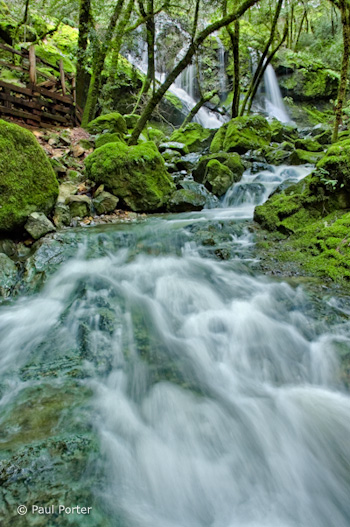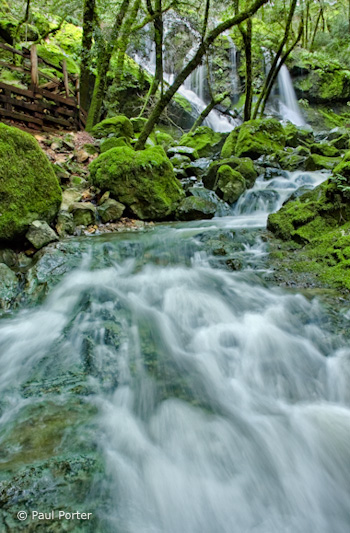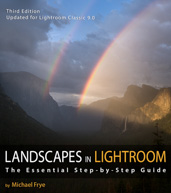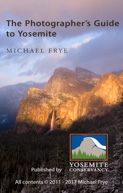In the Moment:
Michael Frye's Landscape Photography Blog
by Michael Frye | Jun 16, 2010 | Critiques
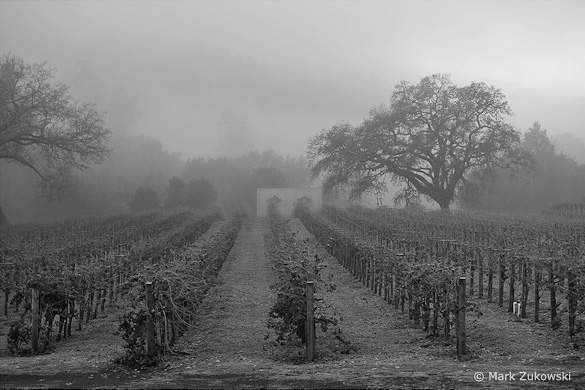
“Fog Shrouded Merlot” by Mark Zukowski
This week’s photograph was made by Mark Zukowski in Sonoma County, California. By having his image chosen for this critique Mark will receive a free 16×20 matted print from Aspen Creek Photo. If you’d like your images considered for future critiques you can upload them to the Flickr group I created for this purpose.
Mark made this image at his own vineyard. Nice place! Finding photogenic areas near your home can reap rewards, allowing you to take advantage of fleeting weather conditions. Mark did that here, using the fog to create a wonderfully moody photograph.
This image was originally captured in color, in Raw. Mark said he initially struggled with the white balance, and that’s one of the reasons he tried converting this to black and white. Here’s the color version, and I see what he means about the white balance: something seems off about the color, although it’s hard to pinpoint whether it’s color temperature or camera calibration. But even if the color could be improved this photograph would still be better in black and white. The slightly warm-toned monochrome treatment adds to the mood and gives the image an old-world feeling that seems appropriate for this setting.
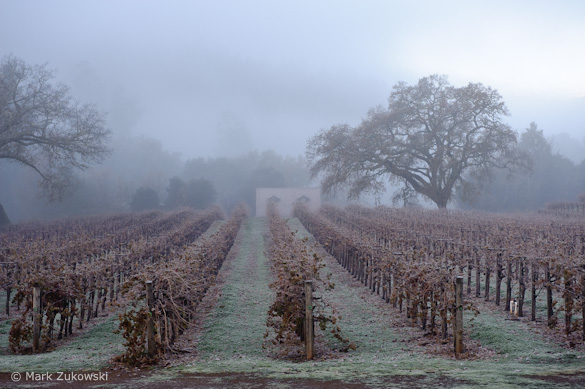
The color version
I like the way the rows of grapevines lead my eyes right to the building in the background. The craggy oak right of center has a great shape, and adds an interesting focal point. Overall the composition works well.
One thing that bothers me however is the patch of dark ground at the very bottom of the frame, as it draws my attention away from more interesting things above. Trimming this edge a bit to eliminate the darkest patches of ground seems to help:
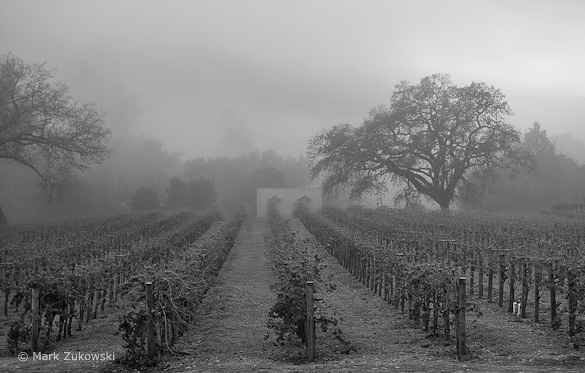
After trimming the bottom edge
We see only part of the tree along the left side, and that’s normally a problem, as prominent elements like this can become distracting when hanging along the edge. Here though that tree seems to work, as it adds an echo to the tree right of center, and cropping it out leaves the left side of the picture somewhat empty.
But perhaps this might have worked even better if Mark had included all of that left-edge tree, creating even stronger repetition between the shapes of the two oaks. Of course there may have been some distracting element just outside the picture that prompted Mark to frame the image this way. Even if there wasn’t, including all of that left-hand tree would have required zooming out and adding either more sky or more foreground, neither of which would be desirable. But cropping into more of a panoramic shape probably would have solved that.
Another idea would have been stepping further to the left, which would have brought the two trees closer together visually. From a certain angle the building could have been neatly framed between the two trees. Of course moving to the left would have changed the alignment of the grapevines, so instead of leading our eyes right to the house they would lead toward the trees left of the house. Another issue is that, as we see it now, the tree right of center stands out clearly against a lighter background; there seems to be a small gap in the trees behind it, allowing lighter fog to show through. Stepping to the left probably would have positioned that tree against the darker vegetation that we now see on the right edge of the frame. So maybe moving to the left wouldn’t have worked, but it’s always worth thinking about different camera positions when you’re there, behind the camera, and have a chance to improve the composition.
Mark used a 70 mm lens on a Nikon D700, giving the image a short telephoto perspective with this full-frame sensor. The exposure was 1/125 sec. at f/5.6 with 200 ISO. This is a pretty wide aperture, and while everything appears looks in focus at this small size, a bigger enlargement might reveal softness in the foreground or background. A smaller aperture, like f/11 or more, might have been a better choice to expand the depth of field and ensure that everything was in focus. Of course this would have required a slower shutter speed and necessitated a tripod.
The exposure and contrast look just right. The sky in the upper-right corner is the brightest part of the scene, but not really where you want people to look most, so that area should probably be darkened a bit.
But overall this photograph is very well done. It has a great mood, enhanced by the warm-toned black-and-white treatment. If you communicate a feeling, you’ve done your job as a photographer.
Thanks Mark for sharing your image! You can see more his work on Flickr.
If you like these critiques, share them with a friend! Email this article, or click on one of the buttons below to post it on Facebook or Twitter.
As part of being chosen for this week’s critique John will receive a free 16×20 matted print courtesy of the folks at Aspen Creek Photo. If you’d like your images considered for future critiques, just upload them to the Flickr group I created for this purpose. If you’re not a Flickr member yet, joining is free and easy. You’ll have to read and accept the rules for the group before adding images, and please, no more than five photos per person per week. I’ll be posting the next critique in two weeks. Thanks for participating!
by Michael Frye | Jun 3, 2010 | Critiques
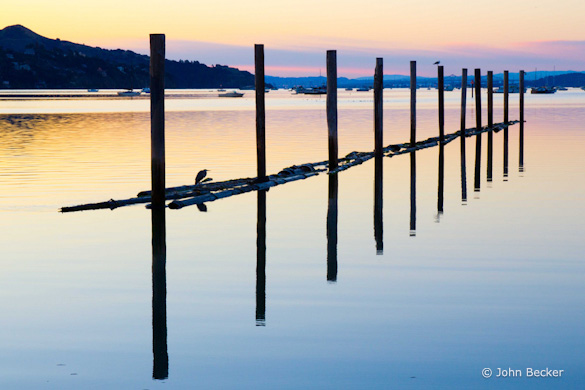
“SunriseSausalito” by John Becker
This week’s photograph was made by John Becker in Sausalito, north of San Francisco. By having his image chosen for this critique Brad will receive a free 16×20 matted print from Aspen Creek Photo. If you’d like your images considered for future critiques you can upload them to the Flickr group I created for this purpose.
The most striking thing about this photograph is the pattern formed by the vertical poles and their reflections. It reminds me of one of my own photographs that I made years ago in another part of San Francisco Bay. These old piers, pilings, and other harbor artifacts can often create interesting designs.
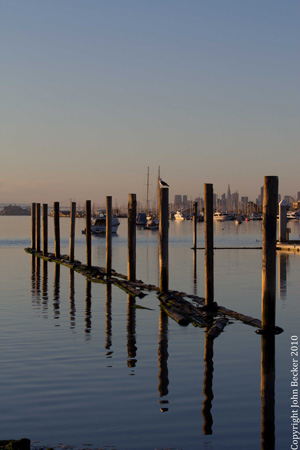
Another composition, made on the same morning, showing San Francisco in the background
John told me that he rose early to drive to this location, and immediately found these posts. He tried various compositions, including some that included the San Francisco skyline in the background (here’s one example), but found too many distractions in that direction. In the end he liked the photograph at the top the best, with the sunrise glow in the sky and without the city skyline.
I certainly agree with this choice. It might have been okay to include San Francisco in the background if there weren’t so many other distractions in that direction—namely all the boats. But what originally attracted John to this scene was the poles and their reflections, not the city. The image at the top, the one John preferred, shows that subject cleanly, with minimal distractions and beautiful light.
The silhouetted heron and gull add nice accents—especially that heron, which is perfectly positioned within the frame. It seems like a small thing, but I don’t think I’d like this photograph nearly as much without the birds. I also love how the reflections of the poles look like they’ve been sliced into little pieces near their tips.
By excluding the San Francisco skyline, John avoided a common photographic disease called “Adding On.” This virus infects photographers when they find an interesting subject or scene, but then say, “Oh, look at that—that’s interesting too. Oh, and I like that also. I wonder if I can fit all those things together in one photograph.” The resulting composition becomes cluttered, and the original idea—the inspiration for the photograph—gets lost and forgotten.
The cure is obvious—stick to the original idea. Ask yourself what caught your eye in the first place, then find a way to show that to it’s best advantage. And make your answer to this questions as precise as possible. In other words, instead of saying, “That tree,” say “The shapes of those branches,” or “The color of the moss on the trunk,” or “The way the light is shining through those leaves.”
John did the first part of that process well here. He was most interested in the poles and their reflections, so he concentrated on those, and resisted the temptation—at least for some images—to include the San Francisco skyline in the background. He found a nice balanced arrangement of the poles and reflections that included the birds and the nice pastel colors.
But there is still some background clutter in the top part of the frame. The distant boats and hills break up the clean lines of the poles and detract from power of all that repetition. Of course it’s hard to find a solution for this; to include the tops of the poles without also including the hills and boats would have required a higher vantage point, something that I assume wasn’t available.
But perhaps John could have gone further and asked himself what it was about those poles and reflections that attracted him. I can’t answer that question for him, but for me it’s the lines and patterns created by those poles and their reflections. I could add other things, like the birds, and the reflections of those pole tips, but they’re not essential.
If you say it’s the poles and their reflections that are most interesting, then there’s no way to avoid the background clutter because you have to include each pole in its entirety. But if you say it’s the lines and patterns that are most captivating, then it becomes possible to show those, without including the boats and hills, by cutting off the tops of the poles. I’ve included a couple of crops that do just that.
Is it worth losing the tops of those poles, and the symmetry and balance they provide, to eliminate the background clutter? I think so, but I’m not sure—I’d have to live with these variations for awhile before making a final decision. The cropped versions are more abstract, which will appeal to some people more than others. The lack of a horizon is also somewhat disorienting, which could be intriguing or confusing, depending on your point of view. As always, I’d love to hear your opinions about this.
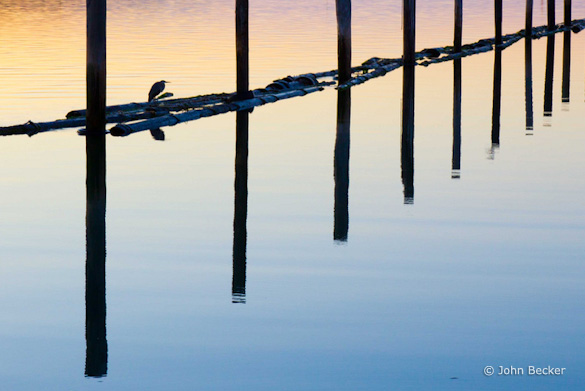
Crop A
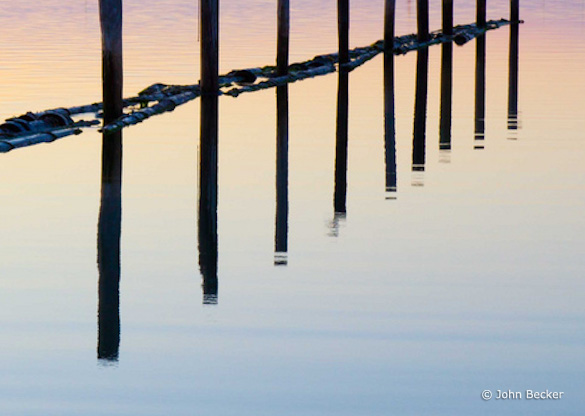
Crop B
But regardless of which version you prefer, my point is that when you’re behind the camera you’ll create more options for yourself if you can be as specific as possible about what attracted you to a scene in the first place. By doing so you may find alternate compositions and approaches and that you wouldn’t have thought of otherwise.
Technically this photograph is well executed—the exposure looks perfect, everything appears to be in focus, and the contrast looks about right. John mentioned that he thought he added a bit too much saturation in this version he posted on Flickr, and in later versions backed off a bit. I’ll concur with that; it’s a fine line, but my first impression was that the saturation was a bit too high and unnatural looking.
An intriguing side note to this image is that John made it just after taking a two-day private workshop in Yosemite with my friend Mike Osborne. John rose early and went to Sausalito to try to take what he had learned from Mike and “do it on my own.” Mike is an excellent teacher who has assisted me in many workshops, and it looks like John learned his lessons well. (For what it’s worth, I didn’t know about this story until after I picked this image for the critique—John does not even have his last name on Flickr, nor would I have recognized it if he did.) Of course I also teach private workshops in Yosemite through The Ansel Adams Gallery.
Thanks John for sharing your image!
As part of being chosen for this week’s critique John will receive a free 16×20 matted print courtesy of the folks at Aspen Creek Photo. If you’d like your images considered for future critiques, just upload them to the Flickr group I created for this purpose. If you’re not a Flickr member yet, joining is free and easy. You’ll have to read and accept the rules for the group before adding images, and please, no more than five photos per person per week. I’ll be posting the next critique in two weeks. Thanks for participating!
by Michael Frye | May 20, 2010 | Critiques
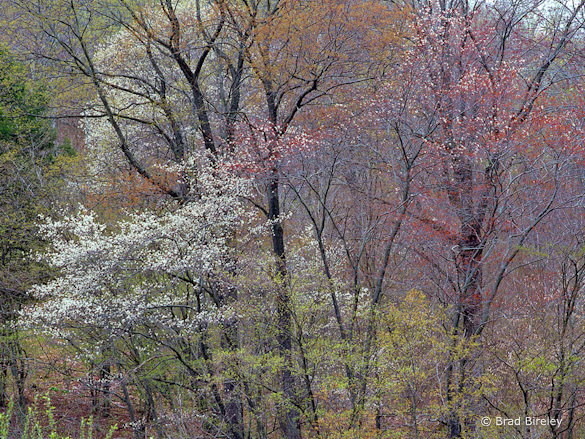
“Springtime in Potter County, PA” by Brad Bireley
Note: I’ve decided to do these critiques every other week from now on, instead of every week. I enjoy doing them, and they’ve been popular and well-received, but I’d like to devote more time to discussing other things that I think will interest you, the readers. Stay tuned!
This week’s photograph was made by Brad Bireley in Potter County, Pennsylvania. By having his image chosen for this critique Brad will receive a free 16×20 matted print from Aspen Creek Photo. If you’d like your images considered for future critiques you can upload them to the Flickr group I created for this purpose.
The soft light of an overcast day was perfect for this photograph. The even illumination helped simplify this complex scene, while sunlight would have created confusing splotches of light and dark. Soft light also helped bring out the beautiful, subtle colors. The varying shades of green, gold, red, and white create a pleasing and varied palette, with a nice warm-cool, red-green color contrast.
Overall the composition is well seen. Brad focused on the area with the most interesting color and texture. He put design before subject and didn’t feel compelled to include the tops or bottoms of the trees out of some misguided attempt to show the whole subject.
The lines of the tree trunks provide structure and prevent the image from becoming a random mish-mash of leaves. The thousands of tiny spots created by the leaves and blossoms add texture and another subtle, repeating pattern, almost like a pointillist painting.
Two small things, however, bother me about the composition. First, the branches in the lower-left corner are slightly out of focus, and their shapes don’t mesh with everything else. Luckily it’s easy to crop a little off the bottom of the photo to eliminate those branches.
The other problem is the bright patch of sky in the upper-right corner. Bright areas draw the eye, and this one pulls viewer’s attention away from all those interesting colors and textures and right out of the frame. Unfortunately, this patch of sky isn’t easily cropped, as trimming the top would also cut off some interesting forks in the upper branches of the left-hand tree.
In search of a solution, I tried darkening the upper-right corner, and several different crops. At the end of this post you’ll find four alternate versions of this image. In version A I darkened the upper-right corner as much I could without making the image look fake and unnatural, but didn’t crop anything. In version B I trimmed a little from the bottom and just enough off the top to eliminate the brightest part of the sky. With C I lopped off all of the sky, and in D also cropped the left and right edges to fill the frame with texture.
I like tight compositions, so I’m partial to Version D, but honestly it’s a tough choice. Let me know what you think!
Technically this is well-executed: the exposure is perfect, and everything is in focus except the small vertical green branches in the lower-left corner I mentioned earlier. The overall contrast looks just right, with small areas of pure black and pure white, just enough to give the image some punch, but not enough to make it look harsh.
Brad said that he didn’t do much to the scan, perhaps adding a bit of saturation. I think a color balance adjustment would also help, as the image has slight blue/purple tint, visible in the branches on the right side of the frame. (I adjusted the white balance slightly in the versions below.)
Despite my nitpicking this is a beautiful photograph, with great colors and textures. Thanks Brad for sharing your image! You can see more his work on Flickr.
As part of being chosen for this week’s critique Brad will receive a free 16×20 matted print courtesy of the folks at Aspen Creek Photo. If you’d like your images considered for future critiques, just upload them to the Flickr group I created for this purpose. If you’re not a Flickr member yet, joining is free and easy. You’ll have to read and accept the rules for the group before adding images, and please, no more than five photos per person per week. I’ll be posting the next critique in two weeks. Thanks for participating!
—Michael Frye
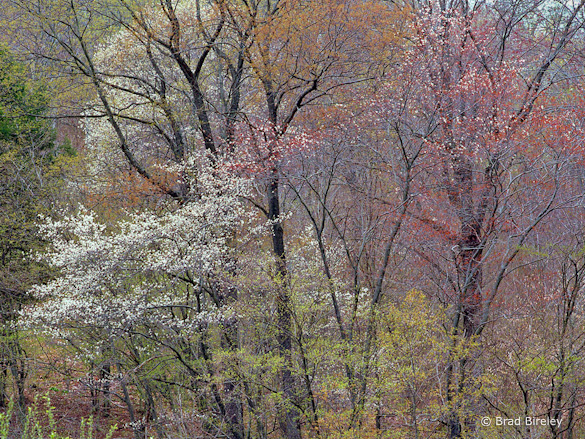
Version A, with the upper-right corner darkened
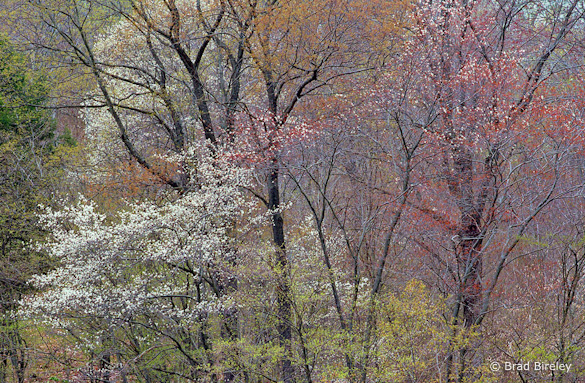
Version B, with top and bottom edges trimmed
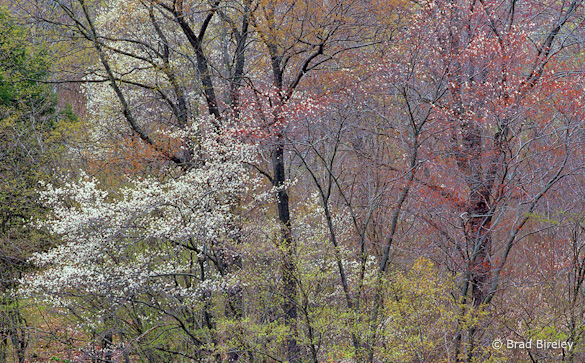
Version C, with the sky cropped out completely
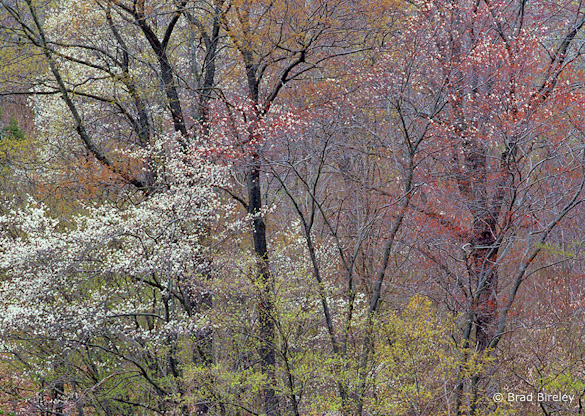
Version D, a tighter crop
by Michael Frye | Apr 14, 2010 | Critiques
Cataract Catwalk” by Paul Porter
This week’s photograph was made by Paul Porter at Mount Tamalpais State Park, north of San Francisco. While last week’s image was a model of simplicity, this scene is much more complex, with cascades, rocks, trees, and the boardwalk railing. I think Paul did a great job of integrating all those elements together and creating a strong composition.
The foreground water is the dominant feature—it fills up almost half the frame. The converging lines of the stream point toward the waterfall at the top, leading our eyes there and creating a nice near-far juxtaposition. That prominent foreground and it’s leading lines hold all the complex elements of the scene together and make a coherent statement out of what could have been a visual mess.
The walkway railing is a man-made object in an otherwise natural scene, and it’s color, lines, and shapes are different from everything else in the frame. Yet despite all that it’s fairly unobtrusive, and you could even make an argument that it adds interest and a human element, allowing viewers to imagine that they could be part of this scene.
One thing that does bother me slightly is the tree trunk in the upper-right corner. Any object that lives on the edge like this can be distracting, and it’s worse if it’s partially cut off—that is, not completely in the photograph or out of it. In this case it’s easy to crop a bit off the right side and eliminate it, and I’ve uploaded another version to show what that looks like. I also trimmed a little off the bottom as well, as after cropping the right edge the bottom of the image seemed a bit too elongated.
Right and bottom edges trimmed
The focal length was 18mm on an APS-size sensor (equivalent to about 28mm on a full-frame sensor). Since wide-angle lenses like this include so much of the scene, it’s easy to allow extraneous elements to creep in and clutter up the image, and it can be challenging to keep the compositions simple. But the strength of short focal lengths is creating the kind of near-far juxtaposition that we see here. Wide-angle lenses make distant objects seem smaller, thereby exaggerating the apparent size difference between near and far, and creating an illusion of depth.
There are two keys to creating that sense of depth with a wide-angle lens. First, you have to put the camera close to something in the foreground—usually no more than five feet away—otherwise everything will look small and distant. Second, you need to keep everything in focus. Paul did both of those things here: the foreground rocks and water appear to be less than three feet from the camera, and everything looks sharp, at least in this small enlargement. Even though this image isn’t the kind of sweeping grand landscape we usually associate with that near-far juxtaposition, there’s a palpable sense of depth and distance between the rocks and water at the bottom of the frame and the trees and fall near the top. You almost feel as though you could walk—or rather wade—into this scene.
Telephoto lenses do the opposite—they compress space and make objects look closer together than they really are. This is great for creating patterns, as you can bring similar lines and shapes into close visual proximity even when they’re physically far apart. From this spot, for example, you could use a longer focal length to zoom in on the trees and waterfall and the top of the frame, working with the patterns created by the trunks and strands of water.
The soft, overcast light was a perfect complement to this scene. Sunlight would have been a contrasty nightmare. Aside from creating severe exposure problems, splotchy highlights and shadows would have added complexity and confusion. Even with the overcast conditions Paul said that he needed to blend two exposures together in Photoshop, since the upper falls were quite a bit brighter than the shadier foreground. This post-processing looks very well done. The merge is seamless—you’d never know that two images had been combined. (I discuss exposure blending in my Digital Zone System article for Outdoor Photographer, and in more detail in my Digital Landscape Photography book.)
The overall contrast and saturation look great. In fact Paul said that he reduced the saturation in some areas after some of the adjustments he made “created a little undesired over-saturation.” The only thing I could quibble with about the processing is the white balance, which to me looks a little blue. This is especially noticeable in the water. To correct this, I used the eyedropper tool in Lightroom and clicked on the water to make it neutral. This worked well for the water, but made the greens a bit too yellow for my taste, so I tweaked the greens to push them closer to their original color. Here are both of these versions for comparison.
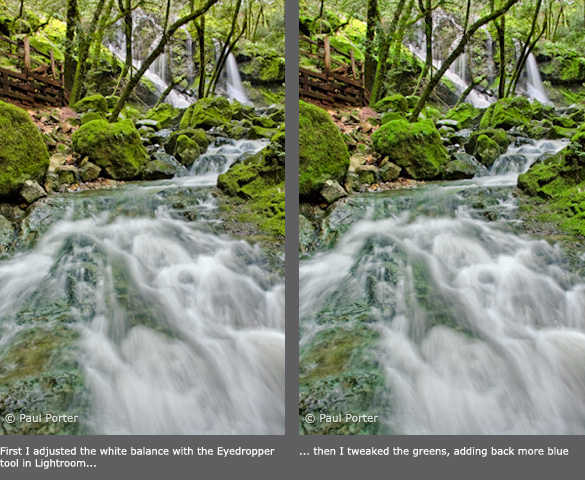
Paul used a shutter speed of 1/2 second for both exposures. This looks about right—slow enough to give the water that silky, flowing look, yet fast enough to prevent the water from losing all texture. There’s a nice contrast between the smooth water and the rough textures of the mossy trees and rocks.
Overall this is very well done—nicely composed, technically well-executed, and skillfully processed.
Thanks Paul for sharing your image! You can see more of his work on Flickr.
If you’d like your images considered for future critiques, just upload them to the Flickr group I created for this purpose. If you’re not a Flickr member yet, joining is free and easy. You’ll have to read and accept the rules for the group before adding images, and please, no more than five photos per person per week. I’ll be posting the next critique on April 20th or 21st. Thanks for participating!
by Michael Frye | Apr 7, 2010 | Critiques
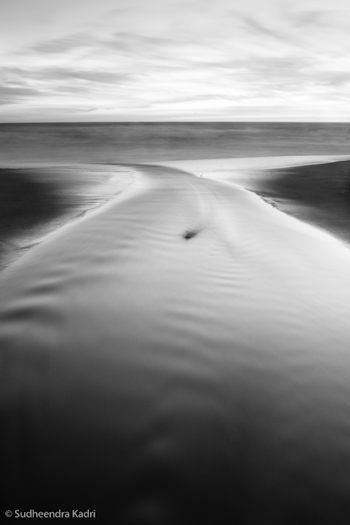
“Outward Momentum, Panther Beach, Davenport, California” by Sudheendra Kadri
This week’s image, by Sudheendra Kadri, was made at Panther Beach in Davenport, California (just north of Santa Cruz).
What initially caught my eye was this photograph’s zen-like simplicity. The entire image consists of only a few lines and shapes. The dominant visual element is the curving X of the stream, resembling a whale’s tail, which in turn is flanked by two triangles of darker sand, then topped by a band of water and lighter expanse of sky. The small dark rock in the center of the frame could be a distraction under different circumstances, but here I think it’s a nice touch, adding a subtle focal point.
In photography, less is usually more, and this image provides a great example of that. The simple, graphic design grabs our attention in a way that more cluttered compositions don’t. But simplicity isn’t simple—in fact it’s quite difficult. The universe wasn’t constructed with photographers in mind; much of the time the world seems to consist of random clutter, with bits of junk and debris thrown in for good measure. The photographer’s job is to find order within that chaos (to paraphrase Robert Glenn Ketchum), to see designs and patterns in the random configurations of the universe.
I talked about seeing abstractly—focusing on lines, shapes, and patterns, rather than thinking about the subject—in my critique from March 24th. I also discuss this in my Digital Landscape Photographybook, and in every workshop I teach. I must think it’s important! Sudheendra said on Flickr, “The way this stream turned sharply before meeting the oncoming waves caught my eyes and I thought this would bring some nice curves and lines into this frame.” So clearly he was thinking abstractly, and that mindset allowed him to see the potential of this scene.
This image’s simple design could only have been created from a particular point of view, which looks like it was the middle of the creek! I asked Sudheendra about that and he confirmed that, yes, he was standing in the water. I guess photographers sometimes have to sacrifice for their art.
The dusk light allowed a 30-second exposure that smoothed the foreground water, giving it that porcelain glow and increasing the level of abstraction by lessening the water’s texture. That soft, glowing, dusky light can be effective for many subjects; the great John Sexton seems to use it almost exclusively.
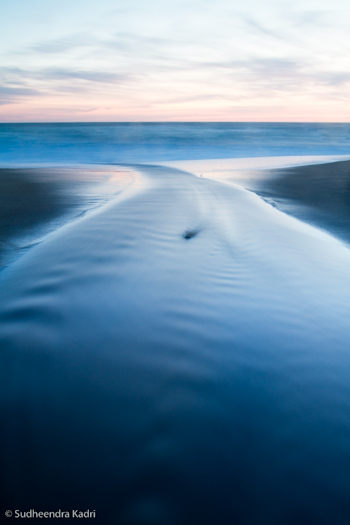
Sudheendra wrote on Flickr, “Shot after sundown, initially I liked the blue-hour colors, but once I saw how it looked in black and white, I wanted to stick with it.” I think that was a key decision, and a good one. Here you can see the color version that Sudheendra sent me for comparison (I added a little contrast to the file to make it closer to the black-and-white version). While the blues and pinks have some appeal, to me the black-and-white image is stronger. By taking away the color the image becomes that much more abstract, focusing our attention on just the lines and shapes, and emphasizing the strong design. We also notice the glassy texture of the foreground water more.
Even if you intend to make the final image black and white it’s usually better to capture the image in full color, as this gives you more options for making that conversion and translating the colors into shades of gray. (With Raw files that’s the only choice—they’re always in color—but some cameras can process JPEGs into black and white.)
Starting with that color image you can use the “Grayscale Mix” in Lightroom or Adobe Camera Raw, or a black-and-white adjustment layer in Photoshop, to alter the tonal relationships between different colors. A classic example is a red apple next to a green apple. A straight black-and-white conversion would make both apples appear medium gray. By adjusting the Grayscale Mix you can make the red apple lighter and the green apple darker, or vice versa. In this “Outward Momentum” photograph, lightening blues would make the foreground water a lighter shade of gray, while darkening magentas would lower the tones of the sky near the horizon. (I discuss these concepts in more detail in my Digital Landscape Photography book.)
But before making these adjustments you have to decide when to convert an image to black and white, and when to leave it in color. Any photograph that lacks color to begin with—a snow scene, or gray tree trunks against gray rocks—is a good candidate for black and white. But other situations are less obvious. To me the question to ask is whether color is adding to photograph’s message and mood, or distracting from it.
In Sudheendra’s photograph, although the original colors are interesting, it turns out that they actually take attention away from the strong, abstract design, which is really the point of the image. As a contrary example, my photograph from Tunnel View that I posted on this blog on February 9th, isn’t particularly colorful, so I tried it in black and white, but decided that the subtle colors, particularly the gold hues in the clouds, actually enhanced the mood, so I kept it in color.
Overall Sudheendra’s photograph is very well done. The only improvement I can think of is to darken the sky a bit, especially near the top, as it’s a bit bright and tends to pull the viewer’s eye out of the frame. But that’s a small thing.
Thanks Sudheendra for sharing your image! You can see more of his work on Flickr.













